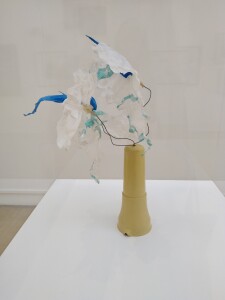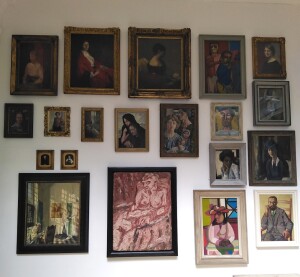I took myself off to Leeds recently, my first time there and part of a post-lockdown plan to visit new places. The atrocious traffic on the way and ferocious wind when I arrived nearly combined to make it a dismal day out. But once I found my way to the Henry Moore Institute and the Leeds Art Gallery, which is right next-door, all was well again.
The Portable Sculpture exhibition at the Institute was the main focus of the trip, my interest having been piqued by my own fold-up and boxed installations. But whereas my impetus is aesthetic and to some extent anti-monumentality, in this show the work reflects the personal circumstances of the artists, some of it linked to the tragedy of fleeing from war and extremism, or of having been prevented from returning home because of it.

Mohamad Hafez, A Refugee Nation

Marcel Duchamp, Boite-en-Valise
Mohamad Hafez, for example, has created miniature worlds in battered suitcases, which detail the decimation of his native Syria. And Hannelore Baron’s box constructions are a response to her traumatic childhood when she fled Nazi Germany – as are those by Louise Bourgeois, her Personages representing the people she left behind. Marcel Duchamp also began making miniature museums of his work when it became apparent that he too would have to leave occupied France. It was intriguing to have a close look at one of these Boites en Valises, which I’d never seen before, only images of them. Here, it was the Green Box with one of his typically enigmatic titles, The Bride Stripped Bare by Her Bachelors, Even. It included a miniature version of his infamous urinal.

Charles Hewlings, Valley Suitcase
But as this show demonstrates there are many reasons for an artist to make portable work. Alexander Calder designed his mobiles as flat packs way before the now ubiquitous Ikea ones for practical reasons, i.e. the air they occupy would have necessitated an inordinately large crate. I particularly enjoyed Charles Hewlings’ Valley Suitcase, which had echoes for me of a 3-D Mondrian. And of course there is digital work, which has become the ultimate transportable artwork. Barry Flanagan was ahead of the game with his films of Hole in the Sea from 1969 and the Pythonesque Bollards Project a year later. This still makes me laugh. How did he get from such innovative work to hares?
One of the largest works is a customised caravan, Andrea Zittel’s A-Z Escape Vehicle. Another is Claire Ashley’s huge inflatable Clown (Laughing Stock). Neither of these stayed in my mind as long as the simplicity of Veronica Ryan’s hanging pillow cases, imbued with her own family history of sewing and containing a few hidden mango seeds that may germinate and emerge through the fabric.

John Skeaping, Woman & Bird

Brian Griffiths, Some Flowers
Next door in the Leeds Art Gallery there is a terrific variety of sculpture on display, though they comprise just a fraction of the 800 objects in the Gallery’s collection. It was a treat to see a John Skeaping alabaster figure almost as soon as one enters the magnificent building – his Woman and Bird, c.1928. I also enjoyed Brian Griffiths’ Some Flowers, made out of everyday discarded materials, and John Davies’ Three Heads made of wood, metal and plaster, which are so small they could easily be part of the portable exhibition. Meanwhile, the mass display on one wall of portrait paintings contained works by some of my favourite artists, among them Keith Vaughan and Leon Kossoff.

Portrait Wall, Leeds Art Gallery

John Davies, Three Heads
A revelation to me was the Art Library, which I wandered into via the Gallery. It was a few minutes before I realised that this was no ordinary public library but one dedicated entirely to art. It boasts around 15,000 books available to loan, covering all aspects of art and design, fashion and graphic arts. There is also a large reference section that includes rare books as well as magazines, exhibition catalogues and sales guides. By the time I stumbled across it, I wasn’t able to stay long enough to enjoy it to the full. But it is inspirational and I will definitely plan to return during the dark days of autumn/winter, of which there is already a whiff in the air.